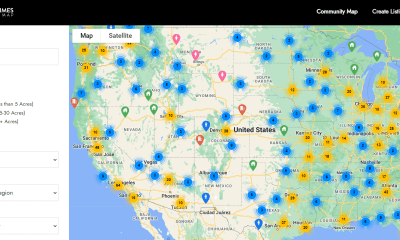Lifestyle
Eleven Principles for Leaders
My troops knew that they would get credit for our success and that any blame for failure would land squarely on my own shoulders.

By: Woodworking Gunny Bear
In my previous writing, ‘Leadership, From J to E,’ I discussed the fourteen leadership traits. Those traits are the basic foundation on which any prospective leader can build. Without them, even a “natural born leader” will inevitably fail to lead even the thirstiest of horses to a watering hole.

For a good leader to become a great leader, they must continuously learn and grow. They have to find every opportunity to apply what they are learning, make mistakes, improve their techniques, and apply what they have learned again. This application of the leadership traits to specific situations can be guided by certain principles. If followed, many negative results will be avoided, and a leader can build on successes, while mistakes can be traced to their causes and corrected. The following leadership principles have proven to be effective in developing great leaders of men and are applicable both on and off the battlefield. (I studied these principles during my career in the military. However, wherever it says “Marine,” you can easily substitute the words employees, community, etc.)
The 11 Marine Corps Leadership Principles are:
1) Know yourself and seek self-improvement
At first glance, this principle seems like an easy one. In actuality, It can be the most difficult. Most people have a hard time being honest about their own weaknesses. I have seen a lot of “leaders” who admit that they need to be more physically fit because they can add a few more points to their physical fitness test to get a perfect score. It is more of a quiet self-compliment about their already adequate fitness level. What they never admit to themselves is that they tend to take the easier, less moral path as long as no one is there to see it. Improvement in the former area might make for a minimally better leader, but improving integrity will make for a significant leap in effective leadership. When seeking self-improvement, focus on those hard truths and areas where you stand to gain the most.
2) Be technically and tactically proficient
Technical proficiency is being good at your specific job. Tactical proficiency is achieved by knowing about other people’s jobs and how to best use everyone’s skills in concert to achieve a specific goal. A good example would be an experienced construction foreman: His construction plans are well laid out, he has gotten all permits prior to beginning a job, and all required supplies have been ordered. He has also scheduled inspections, deliveries, etc.
As the work begins, he keeps the concrete guys, plumbers, carpenters, electricians, etc., on schedule and out of each other’s way. He has an eye for detail and is able to make suggestions and adjustments as required. The result is a quality piece of construction and tradesmen who look forward to working for that foreman in the future.
3) Know your Marines and look out for their welfare
I had quite a few senior leaders during my career. Many of them have mostly faded from my memory (probably assisted by my many brain injuries), but there is one who I will never forget. First Sergeant Conover was an 18-year infantryman and was my senior enlisted leader during my first tour in Iraq. Within a week of joining our 100+ man unit, he knew every Marine’s full name, whether or not they had a wife or children, their general financial situation, as well as any other personal issues they might have. A week or two after that, he familiarized himself further and could tell you what each Marine’s strengths and weaknesses were. If you messed up, the punishment was swift and harsh but always fair. He never mistreated his subordinates and always ensured that they got their mail, chow, and pay. We were all willing to follow him because we knew that in addition to being harder than woodpecker lips, he was GENUINELY concerned with our welfare.
4) Keep your Marines informed
I have never liked leaders who answer questions with, “Because I said so.” I am also in staunch disagreement with the “There’s no such thing as a dumb question” philosophy. Admittedly, I am likely a bit biased after years of fielding hundreds of questions a week as a Marine instructor. Trust me when I say that if you get enough Marines in one room, eventually, somebody will ask a dumb question.
That being said, an effective leader heads off most questions (good ones as well as bad) by keeping those they lead well informed. Whenever possible, a leader should carefully explain how a given task will be accomplished, why that task is important to the overall plan, what each person’s responsibilities are, and what actions should be taken if any likely problems should arise. Also, take some time to specifically cover any safety issues associated and what will ultimately constitute success and failure regarding a task.
Many of those I have led expressed their appreciation of my habit of not withholding any information. They also said how much easier it was for them to make adjustments on the fly since they had all available knowledge at their disposal.
5) Set the example
A leader must always be willing to do whatever it is that they ask of those they lead. An overweight and out-of-shape health teacher deserves to be mocked, not followed. A lazy individual who cuts corners deserves a demotion or firing, not a promotion to a senior position.
Something I learned early on was that your juniors are always watching you and that any sign of hypocrisy will be used by them as an excuse. Any father or mother with a bad habit has heard (or will eventually hear), “…but Dad/Mom, you fill in the blank, so why can’t I?”
A good leader must be beyond reproach and must work even harder than their subordinates. This ensures that they can’t make excuses for failure and that a drive to live up to the leader’s example is instilled within them.
6) Ensure the task is understood, supervised, and accomplished
Supervision is one of the most important tasks that a leader has. While delegating responsibilities to subordinates is often required and offers opportunities for them to take on a leadership role, the senior leader should always conduct a meeting or brief prior to the start of a large project. A quick question and answer session before starting will bring to light any confusion. Here are a few tips for Q and A sessions: Never just say, “Any questions?….No?…Ok, let’s get to it.” Many people won’t ask a question for fear of looking dumb. If no one has a question, go around the horn, asking each person a question related to the project. This will let you know if everyone is on the same page. Also, always leave the door open to ask a question after the brief. That removes the possibility of them “looking dumb” in front of others.
Throughout the project, conduct supervision responsibilities at regular intervals, as well as randomly. This keeps everyone honest. A leader must also recognize when they should step back and let their juniors work. Too much supervision quickly turns into micromanaging and stifles initiative and creativity in subordinates.
When the project is complete, the senior leader should personally conduct an inspection or review and give feedback on everyone’s performance. There is nothing worse than working hard to accomplish a task, and a supervisor doesn’t even bother to inspect the fruits of your labor.
7) Train your Marines as a team
Getting those you lead to work together for a common goal can be difficult. With so many different personalities, there are lots of opportunities for conflict or friction. Setting up activities where everyone spends time together during free time can help build relationships. A good leader can explain how every team member plays a part in the success of a given project. Figuring out what everyone’s strengths and weaknesses are, then building teams based on that will reduce the chance of two people bumping heads during a project. Also, making everyone’s roles clear is helpful here too. Building your smallest team’s cohesion, then incorporating the smaller teams together will help in getting the separate small teams to work together as a cohesive unit.
8) Make sound and timely decisions
This principle is based on a combination of the leadership traits of knowledge, judgment, and decisiveness, and it directly affects a leader’s credibility. Few people will follow someone who consistently makes poor decisions. Similarly, waiting for the situation to develop to the point where the decision is out of your hands is antithetical to being in a leadership role. You need to quickly assess a given situation, weigh the possible consequences of several courses of action, then make a decision and stick with it. A leader can make adjustments to a course of action as the situation develops, but they must ensure everyone is aware of any changes and why the changes were made.
9) Develop a sense of responsibility among your subordinates
A confident leader isn’t constantly looking over their shoulder, worried that someone could supplant them at any time. The saying, “A high tide raises all ships,” relates directly to this leadership principle. A good leader finds ways to put subordinates into positions of responsibility and helps them gain confidence as leaders. In the Marine Corps, we often say that everyone should know the jobs of the two ranks above them. This results in greater rates of success in the event that a given leader is “removed” from the situation. If subordinates don’t voluntarily take charge, make them take charge.
I would often plan these opportunities for our training. I’d conduct a detailed brief and lay out the chain of command. At specific points during training, I would remove key individuals (including myself) from the scenario, forcing juniors to step up and take charge. After observing from a distance, I would bring everyone in to discuss what happened and give advice on what went well and what could be done to improve in the future.
10) Employ your command in accordance with its capabilities
A leader should continuously conduct honest assessments of their team. A leader must make themselves aware of what the team does well, where they are merely adequate, and what they are incapable of. Employ the team based on these assessments, assigning specific tasks based on team members’ strengths and weaknesses. Don’t be afraid to arrange for outside support when it comes to areas where a capability is lacking. For example, if one of your tasks is to build a barn, but no one on your team knows the difference between a hammer and a handsaw, would you stand more chance of success by hoping for the best or by calling in a carpenter? A great leader knows how to task their team and doesn’t set them up for failure by expecting them to work outside of their capabilities.
11) Seek responsibility and take responsibility for your actions
How will you ever be a leader if you don’t seize the opportunity to lead? My time in the Marine Corps is a good example of how well this leadership principle works. In boot camp, squad leaders are fired constantly by Drill Instructors. Each time one was fired, I would sprint up and volunteer for the job. Each time, the Drill Instructors would send me away because I was a disgusting fat body (aka diet recruit, aka anything wider than a bean pole). Finally, after a couple weeks of this happening several times a day, they gave me a chance. I was emplaced as First Squad Leader for Platoon 1057. I made the most of that opportunity and was meritoriously promoted due to my performance. This one act set my entire career on a path of leadership. I was always a Squad Leader, Platoon Sergeant, Instructor, Operations Chief, etc. My troops knew that they would get credit for our success and that any blame for failure would land squarely on my own shoulders. This principle served me well, and I still utilize it today whenever the opportunity arises.
“Leaders aren’t born. They are made. And they are made just like anything else, through hard work. And that’s the price we’ll have to pay to achieve that goal or any goal.”
-Vince Lombardi
Some are considered to be natural-born leaders. With scrutiny, I believe we would find that the situations, experiences, and choices along the way deeply influenced how these individuals gained the mantle of leadership. While there is no formulaic solution to becoming a leader, with hard work and dedication, everyone has the ability to lead when the opportunity arises. Curating the leadership traits and applying them through these leadership principles is a proven means to find success as a leader.

Social media shows doomsayers, pessimists, and even truther-prepper types blasting out warnings of impending doom and gloom. You may feel the urge to fight if you can bear this without your emotions causing you to flee or freeze.
But what does fighting for your future mean? Unfortunately, much internet commentary directs your focus to what others are doing and how they affect you, calling for action to demand change. While this may have its place, it neglects the freedom we already possess and can inadvertently bypass our authority and control.
Here are a few simple things to think about that can help you fight against the future you don’t want, by building the future you do want.
Financial Future
Securing your financial stability is the cornerstone of building a successful future. This starts with becoming debt-free. Debt is a shackle that limits your freedom and ties you to a system you might not align with. Aim to clear your debts quickly and avoid taking on new ones.
Next, focus on land ownership. Owning land provides a place to call home and offers opportunities for self-sufficiency, such as gardening, raising livestock, or even setting up a small business. This autonomy can buffer against economic uncertainties and offer a sense of security.
Continually work towards a sustainable income. Whether through traditional employment, investments, freelancing, or entrepreneurial ventures, ensure your income sources are diversified and resilient to economic shifts. Build skills that are in demand and can be adapted to various roles. Financial independence is crucial in crafting a future you control rather than one external force dictates.
Education
Education is the foundation of personal and professional growth. Embrace self-study and continuous learning. The more skills and knowledge you acquire, the more adaptable you become in a rapidly changing world. Invest in personal improvement by setting aside time for reading, courses, and practical skill-building.
Homeschooling is another powerful tool. It allows you to tailor education to your family’s needs and values, ensuring your children learn what truly matters. Foster a love of learning in your household, emphasizing critical thinking, creativity, and practical skills over rote memorization.
Family Protection
Protecting your family goes beyond physical safety; it involves being a guiding force and a source of stability. We must also protect our families from negative and misguided influences. Be a leader to your children by setting a positive example. Teach them resilience, self-reliance, and the importance of moral values. Strengthen bonds with your siblings through support and cooperation, creating a solid familial network.
Honoring your seniors is equally essential. They possess invaluable wisdom and experience. Encourage intergenerational communication and respect, ensuring your family’s heritage and lessons are passed down.
Mindset
Your mindset is the driving force behind every action. Take ownership of your life and decisions, understanding that responsibility and accountability are keys to freedom. Respect your time and finances, recognizing them as finite resources that require careful management.
Develop a mindset of resilience and adaptability. Life is unpredictable, and being mentally prepared for challenges ensures you can face them head-on. Cultivate a positive outlook, focusing on solutions rather than problems. This proactive attitude will guide you in building the life you want.
Community Building
No one succeeds alone. Connect with people who share your values and vision. Building a community of like-minded individuals offers support, shared resources, and collective wisdom. Engage in activities and friendships that bring joy and complement your life.
We would like to take it a step further by saying, we don’t build the future we want as a reaction to the future we don’t want. We build, because we love, its fun and fulfilling. Our fight is to thrive, not to survive. Survival is a consequence of thriving. So aim high! Take control of your life, embrace self-responsibility, and connect with others on the same path.
Those looking to connect with a broader network should consider joining our Community app. It’s a platform dedicated to bringing together individuals who strive for independence. Whether you’re looking for advice, collaboration, or simply companionship on your journey, our thriving community is a valuable resource.
The power to shape your future is in your hands.
Lifestyle
Making Pine Needle Soda: A Fantastic Foraged Beverage
Pine needle soda, a truly one-of-a-kind beverage, has been savored worldwide for its zesty taste and health benefits.

Pine needle soda, a truly one-of-a-kind beverage, has been savored worldwide for its zesty taste and health benefits. It’s not just a refreshing drink, but also a creative use of natural ingredients. Here’s a simple guide to crafting this unique soda at home.
Pine needles are rich in antioxidants and vitamin C, which help boost the immune system. Different species of needles can offer different flavors, but it’s important to make sure the trees you harvest from are not toxic. Avoid using needles from yew, Norfolk Island pine, or Ponderosa pine. You should do additional research to insure you are staying safe.
The recipe I followed is easy and only requires a jar, strainer, and measuring cups. Start by identifying the pine tree you would like to harvest from; I used fir, tamarack, and white pine. Again, make sure you don’t use anything unsafe. You can choose to use new sprouted tips or even mature needles, which means you can also have fresh pine soda in the winter months!
You can scale up the recipe, but for reference, use the following:
- 2 Cups Pine needles
- 2 Cups Water
- 2-4 Tablespoons sugar (depending on sweetness you desire)
For the above measurements, I recommend using a quart jar. Begin by rinsing the needles, not too thoroughly, because the carbonation comes from natural yeast living on the pine needles. Add the sugar and water and seal the jar. Leave to ferment so it can become bubbly soda! Make sure to “burp” the jar every couple of days to release some of the gas so it does not build up and explode the jar! In 5-7 days, you will have soda, God willing.
Serve over ice and with some citrus if you’d like. Enjoy!
Lifestyle
Reconnect and Rejoice: Beartaria Times Weekly Challenge
Maintaining solid relationships with family and friends offers numerous benefits that enrich our lives in meaningful ways…

In our fast-paced world, losing touch with friends and family members who once played significant roles in our lives is easy. This week, the Beartaria Times invites you to participate in our heartwarming challenge: Reconnect with someone you haven’t spoken to in a while. Give them a call, ask how they’ve been, and rekindle that bond.
Maintaining solid relationships with family and friends offers numerous benefits that enrich our lives in meaningful ways:
1. Emotional Support: Close relationships provide a robust support system during tough times, offering comfort, advice, and a sense of belonging.
2. Improved Mental Health: Regular interactions with loved ones reduces feelings of loneliness and depression, contributing to mental well-being.
3. Increased Longevity: Studies have shown that strong social connections tend to help people live longer and enjoy better health.
4. Enhanced Happiness: Sharing moments, memories, and experiences with others brings joy and fulfillment, fostering a more positive outlook on life.
5. Personal Growth: Friends and family often challenge us to grow, learn, and become better versions of ourselves.
6. Creating Memories: Every interaction creates new memories, adding richness to our personal histories and offering stories to cherish for years to come.
We encourage you to take this challenge to heart and reach out to someone you miss. Whether it’s a friend from high school, a distant relative, or a former colleague, a simple phone call can reignite connections and brighten your day and theirs.
Once you’ve reconnected, share your stories and experiences on the Beartaria Times community app. Post about who you called, the memories you shared, and how the conversation went. Did you learn something new? Did you laugh about old times? These stories can inspire others to take similar steps in their lives.
Join us in this week’s challenge and celebrate the beauty of human connection. Let’s make an effort to nurture our relationships and remind those we care about that they are valued and remembered.
Happy connecting, Beartarians! We look forward to hearing your heartwarming stories.
Sincerly,
– The Beartaria Times Team
-

 Just Crushing2 weeks ago
Just Crushing2 weeks agoChristopher Gardner Completes First Dome Framing Project in Missouri: Exclusive Interview
-

 Just Crushing2 months ago
Just Crushing2 months agoBeartaria Ozark Campground Launches Community Forum!
-

 Just Crushing2 months ago
Just Crushing2 months agoMap it! – Discover Beartarians Living, Working, and Crushing Near You!
-

 Just Crushing2 months ago
Just Crushing2 months agoWhy Do We Feel So Free?
-

 Lifestyle2 months ago
Lifestyle2 months agoReconnect and Rejoice: Beartaria Times Weekly Challenge
-

 Reports2 months ago
Reports2 months agoReport: EF-1 Tornado Touches Down In The Ozarks
-

 Business2 months ago
Business2 months ago3000 Members In Our Business Group!: This Week On Our Community App!
-

 Wellness2 months ago
Wellness2 months agoBeartaria Times Member Shares History and Benefits of Haymaker’s Punch





































